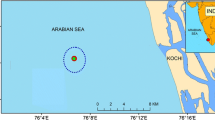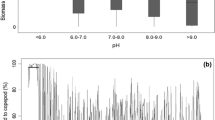Abstract
The zooplankton community of the brackish part of the Westerschelde estuary (November 1989–October 1990) was dominated by two calanoid copepods, Eurytemora affinis and Acartia tonsa. Eurytemora was present during a longer period of the year and was much more important in terms of total abundances and biomasses than Acartia.
The secondary production of these species was estimated by means of the growth rate method, using weight-specific growth rates obtained from laboratory cultures (Eurytemora) or from the literature (Acartia).
Due to the substantially higher growth rates of Acartia compared to Eurytemora, total yearly productions of both communities were comparable, notwithstanding the large discrepancies in biomass. They amounted to about 5 and 6 g C m−2 y−1 by Acartia and Eurytemora respectively.
The food needed to realise this production was estimated to be about 14 and 17 g C m−2 y−1 by Acartia and Eurytemora respectively. Provided that the copepods are able to selectively ingest the phytoplankton, in situ net production provides sufficient carbon for zooplankton demands for a short period of the year only. As phytoplankton standing stock is very low and net phytoplankton productivity is negative from late fall to early spring, nutritional demands of the copepods have to be fulfilled by other than algal food at least during this period of the year.
Although the copepods in the brackish part can have an important impact on some food items, their contribution to total carbon fluxes in the brackish zone is negligible: each year some 6% of all consumed carbon in the brackish part of the estuary passes through the copepod food web.
Similar content being viewed by others
References
Bakker, C. & N. De Pauw, 1975. Comparison of plankton assemblages of identical salinity ranges in estuarine tidal and stagnant environments. II. Zooplankton. Neth. Journ. Sea Res, 9 (2): 145–165.
Bakker, C., W. J. Phaff, M.v Ewijk-Rosier & N. De Pauw, 1977. Copepod biomass in an estuarine and a stagnant brackish environment of the S.W. Netherlands. Hydrobiologia, 52 (1): 3–13.
Barthel, K. G., 1983. Food uptake and growth efficiecy of Eurytemora affinis (Copepoda: Calanoida). Mar. Biol., 74: 269–274.
Bergreen, U., B. Hansen & T. Kiørboe, 1988. Food size spectra, ingestion and growth of the copepod Acartia tonsa during development: implications for determination of copepod production. Mar. Biol., 99: 341–352.
Billen, G., C. Lancelot, E. De Becker & P. Servais, 1988. Modelling microbial processes (phyto- and bacterioplankton) in the Schelde Estuary. Hydrobiol. Bull. 22: 43–55.
Bradley, B. P., 1975. The anomalous influence of salinity on temperature tolerances of summer and winter populations of the copepod Eurytemora affinis. Biol. Bull., 148: 26–34.
Burkill, P. H. and T. F. Kendall, 1982. Production of the copepod Eurytemora affinis in the Bristol Channel. Mar. Ecol. Prog. Ser., 7: 21–31.
Castel, J., 1991. Comparative field study of the ecological structure of major european tidal estuaries: the Gironde estuary. Major Biological Processes in European Tidal Estuary. JEEP 92, Plymouth Jan. 29–Feb. 1 1992: 55–67.
Castel, J. & J. Veiga, 1990. Distribution and retention of the copepod Eurytemora affinis hirundoides in a turbid estuary. Mar. Biol., 107: 119–128.
Durbin, E. G., A. G. Durbin, T. J. Smayda & P. G. Verity, 1983. Food limitation of production by adult Acartia tonsa in Narragansett Bay, Rhode Island. Limnol. Oceanogr. 28 (6): 1199–1213.
Duursma, E. K., A. G. A. Mercks & J. Nieuwenhuize, 1988. Exchange processes in estuaries such as the Westerschelde, an overview. Hydrobiol. Bull. 22 (1): 7–20.
Escaravage, V. & K. Soetaert, 1993. Estimating secondary production for the brackish Werterschelde copepod population Eurytemora affinis (Poppe) combining experimental data and field observations. Cah. Biol. Mar., 34: 201–214.
Gaedke, U., 1990. Population dynamics of the calanoid copepods Eurytemora affinis and Acartia tonsa in the Ems-Dollart-Estuary: a numerical simulation. Arch. Hydrobiol., 118 (2): 185–226.
Goosen, N., P. van Rijswijk, J. Peene & J. Kromkamp, 1992. Annual patterns of bacterial production in the Scheldt estuary (SW-Netherlands). Major Biological Processes in European Tidal Estuary. JEEP 92 report, Plymouth Jan. 29–Feb. 1 1992: 109–113.
Heinle, D. R., 1969. Temperature and zooplankton. Chesapeake Sci., 10: 186–209.
Heinle, D. R. & D. A. Flemer, 1975. Carbon requirements of a population of the estuarine copepod Eurytemora affinis. Mar. Biol. 31: 235–247.
Heip, C., M. Vincx & G. Vranken, 1985. The ecology of marine nematodes. Oceanogr. Mar. Biol. Ann. Rev., 23: 399–489.
Heip, C., 1988. Biota and abiotic environment in the Westerschelde estuary. Hydrobiol. Bull. 22: 31–34.
Hirche, H. J., 1992. Egg production of Eurytemora affinis — effect of k-strategy. Est. coast. Shelf Sci. 35: 395–407.
Hummel, H., G. Moerland & C. Bakker, 1988. The concomitant existence of a typical coastal and a detritus food chain in the Westerschelde estuary. Hydrobiol. Bull. 22: 35–41.
Huntley, M. E. & M. D. G. Lopez, 1992. Temeperature dependent production of marine copepods: a global synthesis. Am. Nat., 140 (2): 201–242.
Kiørboe, T., F. Mohlenberg & F. Hamburger, 1985. Bioenergetics of the planktonic copepod Acartia tonsa: relation between feeding, egg production and respiration, and composition of specific dynamic action. Mar. Ecol Prog. Ser. 26: 85–97.
Kimmerer, W. J., 1987. The theory of secondary production calculations for continuously reproducing populations. Limnol. Oceanogr., 32 (1): 1–13.
Klein Breteler, W. C. M., H. G. Fransz & S. R. Gonzalez, 1982. Growth and development of four calanoid copepod species under experimental and natural conditions. Neth. J. Sea. Res., 16: 195–207.
Klein Breteler, W. C. M. & S. R. Gonzalez, 1988. Influence of temperature and food concentration on body size, weight and lipid content of two calanoid copepod species. Hydrobiologia, 167/168 (Dev. Hydrobiol. 47): 201–210.
Kleppel, G. S., 1992. Environmental regulation of feeding and egg production by Acartia tonsa of Southern California. Mar. Biol., 112: 57–65.
Kleppel, G. S., 1993. On the diets of calanoid copepods. Mar. Ecol. Prog. Ser. 99: 183–195.
Kromkamp, J., J. Peene, P. van Rijswijk, A. Sandee & N. Goosen 1995. Nutrients, light and primary production by phytoplankton and microphytobenthos in the eutrophic, turbid Westerschelde estuary (The Netherlands). Hydrobiologia 311 (Dev. Hydrobiol. 110): 9–19.
Landry, M. R., 1978. Population dynamics and production of a planktonic marine copepod, Acartia clausi in a small temperate lagoon on San Juan Island, Washington. Int. Rev. ges. Hydrobiol., 63 (1): 77–119.
Lenz, J., 1974. On the amount and size distribution of suspended matter in Kiel Bight. Ber. dt. wiss. Kommn. Meeresforsch., 23: 209–225.
Mauchline, J., 1970. The biology of Schistomysis ornata (Crustacea: Misidacea). J. mar. biol. Ass. U.K. 50: 169–175.
Miller, C. B, D. R. Heinle & J. K. Johnson, 1977. Growth rules in the marine copepod genus Acartia. Limnol. Oceanogr. 22 (5): 326–335.
Parrish, K. K. & D. F. Wilson, 1978. Fecundity studies on Acartia tonsa (Copepoda: Calanoida) in standardized culture. Mar. Biol. 46: 65–81.
Poli, J. M. & J. Castel, 1983. Cycle biologique en laboratoire d'un copepode planctonique de l'estuare de la Gironde: Eurytemora hirundoides (Nordquist, 1888). Vie Milieu 33 (2): 79–86.
Polishchuk, L. V., 1990. A comment on the ‘theory of secondary production calculations for continuously reproducing populations’ (Kimmerer). Limnol. Oceanogr. 32 (6): 1645–1651.
Poulet, S. A., 1983. Factors controlling utilization of non-algal diets by particle-grazing copepods. A review. Oceanol. Acta, 6 (3): 221–234.
Parslow, J. & N. C. Sonntag, 1979. Technique of systems identification applied to estimating copepod population parameters. J. Plankt. Res. 1 (2): 137–151.
Raymont, J. E. G. & R. S. Miller, 1962. Production of zooplankton with fertilization in an enclosed body of sea water. Int. Rev. Gesam. Hydrobiol., 47: 169–209.
Rigler, H. & J. A. Downing, 1984. The calculation of secondary productivity. In: Downing J. A. & F. H. Rigler (eds), A manual on methods for the assessment of secondary productivity in fresh waters: 19–58.
Roman, M. R., 1984. Utilization of detritus by the copepod Acartia tonsa. Limnol. Oceanogr., 29 (25): 949–959.
Sekigushi, H., I. A. McLaren & C. J. Corkett, 1980. Relationship between growth rate and egg production in the copepod Acartia clausi hudsonica. Mar. Biol. 58: 133–138.
Soetaert, K. & P. van Rijswijk, 1993. Spatial and temporal patterns in Westerschelde zooplankton. Mar. Ecol. Prog. Ser., 97: 47–59.
Soetaert, K. & P. M. J. Herman, 1994. One foot in the grave: zooplankton drift into the Westerschelde estuary (The Netherlands). Mar. Ecol. Prog. Ser. 105: 19–29.
Soetaert, K. & P. M. J. Herman, 1995a. Estimating estuarine residence times in the Westerschelde (The Netherlands) using a box model with fixed dispersion coefficients. Hydrobiologia 311 (Dev. Hydrobiol. 110): 215–224.
Soetaert, K. & P. M. J. Herman, 1995b. Carbon flows in the Westerschelde estuary (The Netherlands) evaluated by means of an ecosystem model (MOSES). Hydrobiologia 311 (Dev. Hydrobiol. 110): 247–266.
Soetaert, K. & P. M. J. Herman, 1995c. Nitrogen dynamics in the Westerschelde estuary (SW Netherlands) estimated by means of the ecosystem model MOSES. Hydrobiologia 311 (Dev. Hydrobiol. 110): 225–246.
Soetaert, K., P. M. J. Herman & J. Kromkamp, 1994. Living in the twilight: estimating net phytoplankton growth in the Westerschelde estuary (The Netherlands) by means of an ecosystem model (MOSES). J. plankt. Res. 16: 1277–1301.
Stottrup, J. G. & J. Jensen, 1990. Influence of algal diet on feeding and egg production of the calanoid copepod Acartia tonsa Dana. J. Exp. Mar. Biol. Ecol. 141: 87–105.
Tranter, D. J., 1976. Herbivore production. In: D. H. Cushings and J. J. Walsh (eds), The ecology of the seas. Chapter 9: 186–224.
Uye, S., 1981. Fecundity studies of neritic copepods Acartia clausi Giesbrecht and A. steueri Smimov: a simple empirical model of daily production. J. exp. mar. Biol. Ecol. 50: 255–271.
Vuorinen, I., 1982. The effect of temperature on the rate of development of Eurytemora hirundoides (Nordquist) in laboratory culture. Ann. Zool. Fenn. 19: 129–134.
Wollast, R., 1976. Transport et accumulation de polluants dans l'estuaire de l'Escaut. In J. C. Nihoul & R. Wollast (eds). l'Estuaire de l'Escaut. Projet Mer Rapport final. Bruxelles. Service du Premier Ministre 10: 191–201.
Author information
Authors and Affiliations
Rights and permissions
About this article
Cite this article
Escaravage, V., Soetaert, K. Secondary production of the brackish copepod communities and their contribution to the carbon fluxes in the Westerschelde estuary (The Netherlands). Hydrobiologia 311, 103–114 (1995). https://doi.org/10.1007/BF00008574
Issue Date:
DOI: https://doi.org/10.1007/BF00008574




